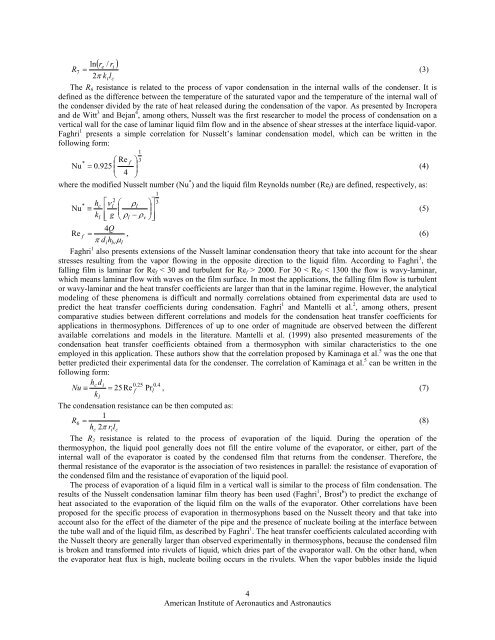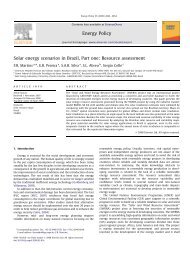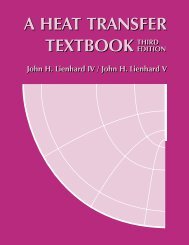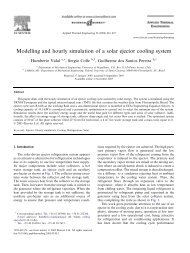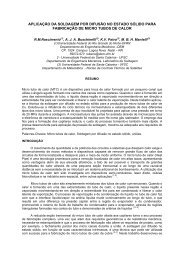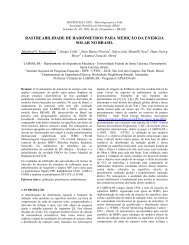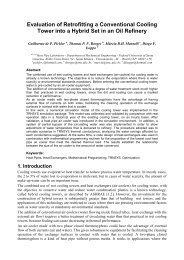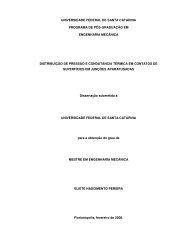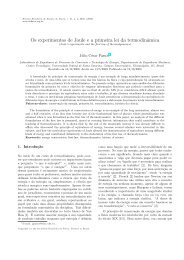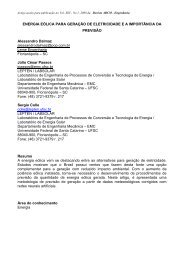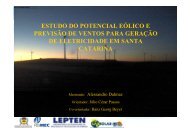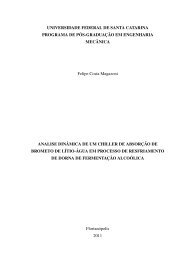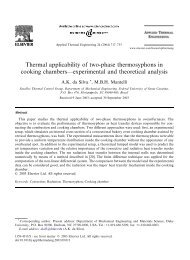Tree Configuration Thermosyphon Study - LEPTEN
Tree Configuration Thermosyphon Study - LEPTEN
Tree Configuration Thermosyphon Study - LEPTEN
Create successful ePaper yourself
Turn your PDF publications into a flip-book with our unique Google optimized e-Paper software.
( r / r )<br />
ln e i<br />
R7 = 2π k l<br />
(3)<br />
t c<br />
The R 6 resistance is related to the process of vapor condensation in the internal walls of the condenser. It is<br />
defined as the difference between the temperature of the saturated vapor and the temperature of the internal wall of<br />
the condenser divided by the rate of heat released during the condensation of the vapor. As presented by Incropera<br />
and de Witt 3 and Bejan 4 , among others, Nusselt was the first researcher to model the process of condensation on a<br />
vertical wall for the case of laminar liquid film flow and in the absence of shear stresses at the interface liquid-vapor.<br />
Faghri 1 presents a simple correlation for Nusselt’s laminar condensation model, which can be written in the<br />
following form:<br />
1<br />
3<br />
*<br />
⎛ Re f ⎞<br />
Nu = 0.925 ⎜ ⎟<br />
4<br />
(4)<br />
⎝ ⎠<br />
where the modified Nusselt number (Nu * ) and the liquid film Reynolds number (Re f ) are defined, respectively, as:<br />
1<br />
3<br />
2<br />
* h ⎡<br />
⎤<br />
c ν l<br />
⎛ ρ ⎞<br />
Nu ⎢<br />
⎜<br />
l<br />
≡<br />
⎟⎥<br />
(5)<br />
kl<br />
⎢⎣<br />
g ⎝ ρl<br />
− ρv<br />
⎠⎥⎦<br />
4Q<br />
Re f = , (6)<br />
π d h µ<br />
i<br />
lv<br />
l<br />
Faghri 1 also presents extensions of the Nusselt laminar condensation theory that take into account for the shear<br />
stresses resulting from the vapor flowing in the opposite direction to the liquid film. According to Faghri 1 , the<br />
falling film is laminar for Re f < 30 and turbulent for Re f > 2000. For 30 < Re f < 1300 the flow is wavy-laminar,<br />
which means laminar flow with waves on the film surface. In most the applications, the falling film flow is turbulent<br />
or wavy-laminar and the heat transfer coefficients are larger than that in the laminar regime. However, the analytical<br />
modeling of these phenomena is difficult and normally correlations obtained from experimental data are used to<br />
predict the heat transfer coefficients during condensation. Faghri 1 and Mantelli et al. 2 , among others, present<br />
comparative studies between different correlations and models for the condensation heat transfer coefficients for<br />
applications in thermosyphons. Differences of up to one order of magnitude are observed between the different<br />
available correlations and models in the literature. Mantelli et al. (1999) also presented measurements of the<br />
condensation heat transfer coefficients obtained from a thermosyphon with similar characteristics to the one<br />
employed in this application. These authors show that the correlation proposed by Kaminaga et al. 5 was the one that<br />
better predicted their experimental data for the condenser. The correlation of Kaminaga et al. 5 can be written in the<br />
following form:<br />
hcdi<br />
0.25 0.4<br />
Nu ≡ = 25 Re f Prl<br />
, (7)<br />
kl<br />
The condensation resistance can be then computed as:<br />
1<br />
R6 = hc<br />
2π ri<br />
l<br />
(8)<br />
c<br />
The R 2 resistance is related to the process of evaporation of the liquid. During the operation of the<br />
thermosyphon, the liquid pool generally does not fill the entire volume of the evaporator, or either, part of the<br />
internal wall of the evaporator is coated by the condensed film that returns from the condenser. Therefore, the<br />
thermal resistance of the evaporator is the association of two resistences in parallel: the resistance of evaporation of<br />
the condensed film and the resistance of evaporation of the liquid pool.<br />
The process of evaporation of a liquid film in a vertical wall is similar to the process of film condensation. The<br />
results of the Nusselt condensation laminar film theory has been used (Faghri 1 , Brost 6 ) to predict the exchange of<br />
heat associated to the evaporation of the liquid film on the walls of the evaporator. Other correlations have been<br />
proposed for the specific process of evaporation in thermosyphons based on the Nusselt theory and that take into<br />
account also for the effect of the diameter of the pipe and the presence of nucleate boiling at the interface between<br />
the tube wall and of the liquid film, as described by Faghri 1 . The heat transfer coefficients calculated according with<br />
the Nusselt theory are generally larger than observed experimentally in thermosyphons, because the condensed film<br />
is broken and transformed into rivulets of liquid, which dries part of the evaporator wall. On the other hand, when<br />
the evaporator heat flux is high, nucleate boiling occurs in the rivulets. When the vapor bubbles inside the liquid<br />
4<br />
American Institute of Aeronautics and Astronautics


